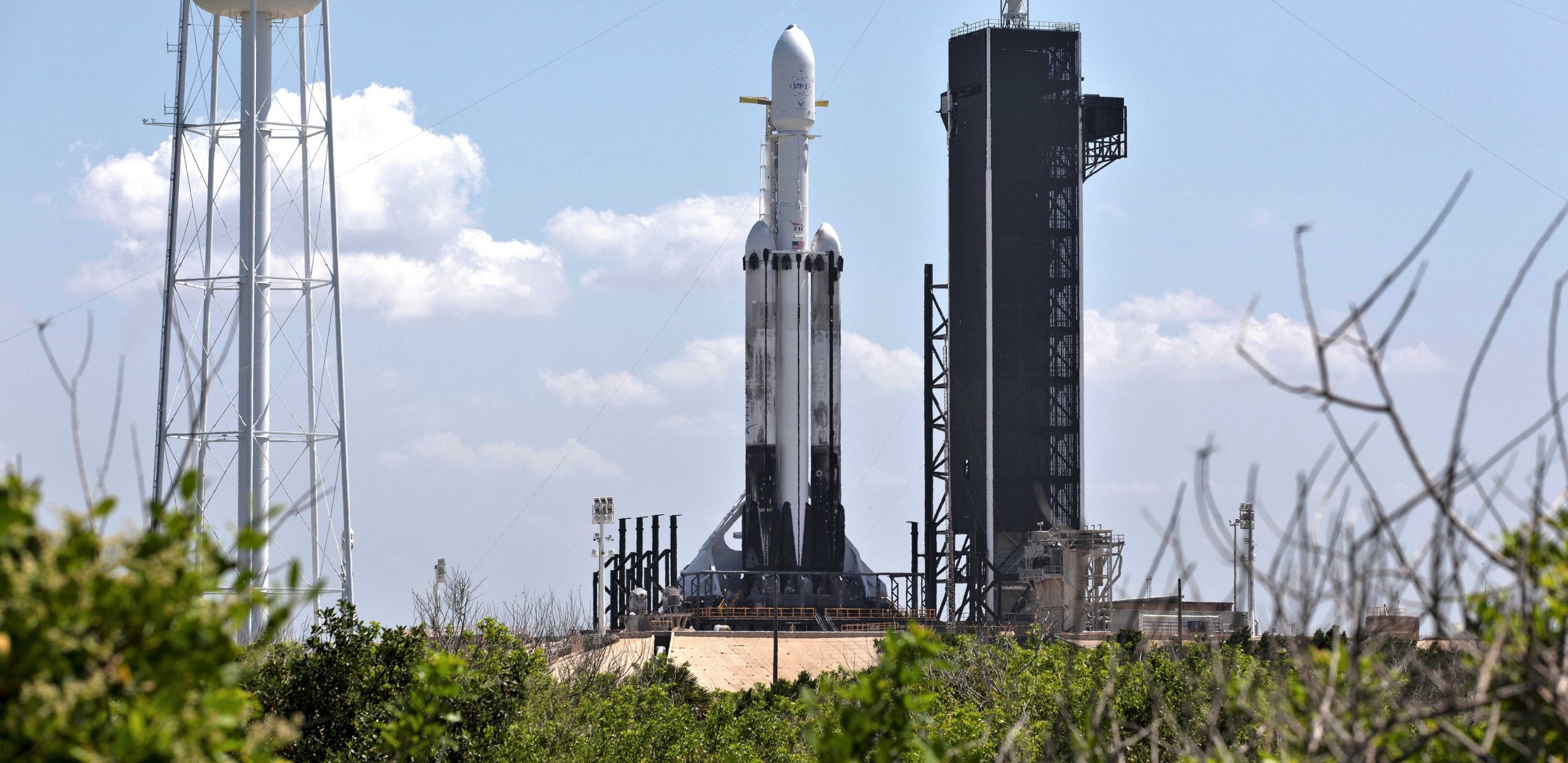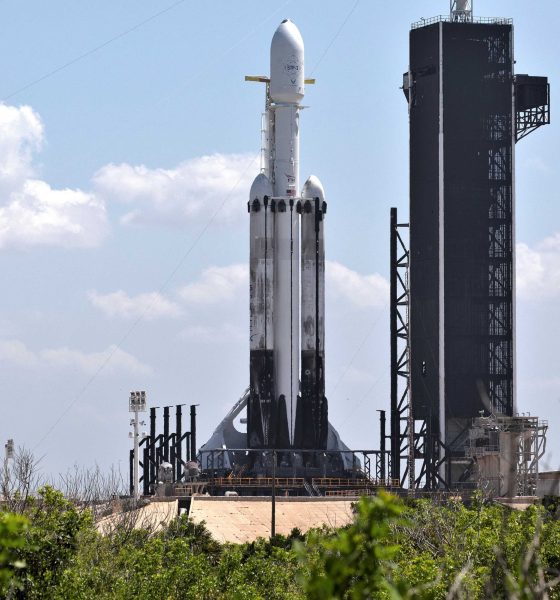

News
SpaceX to launch Falcon Heavy rocket 3 times in 6 months after latest payload delay
For at least the second time in 2021, unspecified issues with a US military payload have delayed SpaceX’s next Falcon Heavy launch, this time pushing the mission into next year.
Known as USSF-44 (formerly AFSPC-44), the US Air Force (now Space Force) contracted a SpaceX Falcon Heavy rocket in February 2019 to launch the classified payload for roughly $150M in fiscal year 2021 (no earlier than Q4 2020). Gradually, USSF-44 slipped without explanation to Q2 2021, at which point SpaceX had fully qualified and delivered all three new Falcon Heavy boosters and an expendable upper stage for the mission. After two more slips to July and October 2021, a US military official finally offered the first hint of an explanation for what now amounted to a full year of delays, explaining that USSF-44 had been pushed into Q4 “to accommodate payload readiness.”
Translated from US military doublespeak and euphemism, the manufacturer (likely Lockheed Martin, Northrop Grumman, or Boeing) building USSF-44’s classified payload(s) ran into or create issues that caused at least 3-6 months of delays. Now, per official comments obtained from a Space Force spokesperson by Spaceflight Now, USSF-44 has again been delayed several months “to accommodate payload readiness,” pushing Falcon Heavy’s fourth launch ever from October 2021 to no earlier than (NET) Q1 2022.
USSF-44’s latest delay means that SpaceX is now likely to go a full 30 months between Falcon Heavy flights after completing the rocket’s third and most recent launch in June 2019. The slip to “early 2022” also leaves the company with an extremely ambitious launch manifest in the first half of 2022. Barring one or several significant delays, which now seems like the most plausible outcome, SpaceX has four major Falcon Heavy missions – USSF-44, USSF-52, ViaSat-3, and NASA’s Psyche probe – scheduled to launch set to launch by August, with three of the four scheduled in H1 2022. A fifth mission – USSF-67 – is scheduled to launch in Q4 2022 and likely on another Falcon Heavy rocket, though the US military has yet to specify the Falcon variant.
Further, requiring the use of the same Kennedy Space Center (KSC) LC-39A pad, SpaceX also has at least six Crew and Cargo Dragon launches scheduled in February (Ax-1), April (Crew-4), May (CRS-25), Q3 (Ax-2), September (CRS-26), and October 2022 (Crew-5). In other words, in Dragon and Falcon Heavy missions alone, SpaceX already has 10-11 launches scheduled in 2022 – all of which require the use of Pad 39A. If SpaceX manages to pull that off on top of a myriad of other commercial and Starlink launches scheduled next year, it will be a feat to remember.
Barring additional delays, USSF-44 will be SpaceX’s first direct launch to geostationary orbit (GEO), requiring the Falcon upper stage to survive a multi-hour coast through and inside two radiation belts before reigniting for a circularization burn some 35,800 km (22,300 mi) above Earth’s surface. However, a rideshare payload transferred to SpaceX’s ViaSat-3 communications satellite launch recently revealed that SpaceX also intends to send those payloads directly to GEO in Q2 2022, meaning that another few months could force the company to leapfrog USSF-44.
For now, fans of the most powerful operational rocket in the world will have to wait at least another three months for its next launch.

News
Tesla FSD fleet is nearing 7 billion total miles, including 2.5 billion city miles
As can be seen on Tesla’s official FSD webpage, vehicles equipped with the system have now navigated over 6.99 billion miles.

Tesla’s Full Self-Driving (Supervised) fleet is closing in on almost 7 billion total miles driven, as per data posted by the company on its official FSD webpage.
These figures hint at the massive scale of data fueling Tesla’s rapid FSD improvements, which have been quite notable as of late.
FSD mileage milestones
As can be seen on Tesla’s official FSD webpage, vehicles equipped with the system have now navigated over 6.99 billion miles. Tesla owner and avid FSD tester Whole Mars Catalog also shared a screenshot indicating that from the nearly 7 billion miles traveled by the FSD fleet, more than 2.5 billion miles were driven inside cities.
City miles are particularly valuable for complex urban scenarios like unprotected turns, pedestrian interactions, and traffic lights. This is also the difference-maker for FSD, as only complex solutions, such as Waymo’s self-driving taxis, operate similarly on inner-city streets. And even then, incidents such as the San Francisco blackouts have proven challenging for sensor-rich vehicles like Waymos.
Tesla’s data edge
Tesla has a number of advantages in the autonomous vehicle sector, one of which is the size of its fleet and the number of vehicles training FSD on real-world roads. Tesla’s nearly 7 billion FSD miles then allow the company to roll out updates that make its vehicles behave like they are being driven by experienced drivers, even if they are operating on their own.
So notable are Tesla’s improvements to FSD that NVIDIA Director of Robotics Jim Fan, after experiencing FSD v14, noted that the system is the first AI that passes what he described as a “Physical Turing Test.”
“Despite knowing exactly how robot learning works, I still find it magical watching the steering wheel turn by itself. First it feels surreal, next it becomes routine. Then, like the smartphone, taking it away actively hurts. This is how humanity gets rewired and glued to god-like technologies,” Fan wrote in a post on X.
News
Tesla starts showing how FSD will change lives in Europe
Local officials tested the system on narrow country roads and were impressed by FSD’s smooth, human-like driving, with some calling the service a game-changer for everyday life in areas that are far from urban centers.

Tesla has launched Europe’s first public shuttle service using Full Self-Driving (Supervised) in the rural Eifelkreis Bitburg-Prüm region of Germany, demonstrating how the technology can restore independence and mobility for people who struggle with limited transport options.
Local officials tested the system on narrow country roads and were impressed by FSD’s smooth, human-like driving, with some calling the service a game-changer for everyday life in areas that are far from urban centers.
Officials see real impact on rural residents
Arzfeld Mayor Johannes Kuhl and District Administrator Andreas Kruppert personally tested the Tesla shuttle service. This allowed them to see just how well FSD navigated winding lanes and rural roads confidently. Kruppert said, “Autonomous driving sounds like science fiction to many, but we simply see here that it works totally well in rural regions too.” Kuhl, for his part, also noted that FSD “feels like a very experienced driver.”
The pilot complements the area’s “Citizen Bus” program, which provides on-demand rides for elderly residents who can no longer drive themselves. Tesla Europe shared a video of a demonstration of the service, highlighting how FSD gives people their freedom back, even in places where public transport is not as prevalent.
What the Ministry for Economic Affairs and Transport says
Rhineland-Palatinate’s Minister Daniela Schmitt supported the project, praising the collaboration that made this “first of its kind in Europe” possible. As per the ministry, the rural rollout for the service shows FSD’s potential beyond major cities, and it delivers tangible benefits like grocery runs, doctor visits, and social connections for isolated residents.
“Reliable and flexible mobility is especially vital in rural areas. With the launch of a shuttle service using self-driving vehicles (FSD supervised) by Tesla in the Eifelkreis Bitburg-Prüm, an innovative pilot project is now getting underway that complements local community bus services. It is the first project of its kind in Europe.
“The result is a real gain for rural mobility: greater accessibility, more flexibility and tangible benefits for everyday life. A strong signal for innovation, cooperation and future-oriented mobility beyond urban centers,” the ministry wrote in a LinkedIn post.
News
Tesla China quietly posts Robotaxi-related job listing
Tesla China is currently seeking a Low Voltage Electrical Engineer to work on circuit board design for the company’s autonomous vehicles.

Tesla has posted a new job listing in Shanghai explicitly tied to its Robotaxi program, fueling speculation that the company is preparing to launch its dedicated autonomous ride-hailing service in China.
As noted in the listing, Tesla China is currently seeking a Low Voltage Electrical Engineer to work on circuit board design for the company’s autonomous vehicles.
Robotaxi-specific role
The listing, which was shared on social media platform X by industry watcher @tslaming, suggested that Tesla China is looking to fill the role urgently. The job listing itself specifically mentions that the person hired for the role will be working on the Low Voltage Hardware team, which would design the circuit boards that would serve as the nervous system of the Robotaxi.
Key tasks for the role, as indicated in the job listing, include collaboration with PCB layout, firmware, mechanical, program management, and validation teams, among other responsibilities. The role is based in Shanghai.
China Robotaxi launch
China represents a massive potential market for robotaxis, with its dense urban centers and supportive policies in select cities. Tesla has limited permission to roll out FSD in the country, though despite this, its vehicles have been hailed as among the best in the market when it comes to autonomous features. So far, at least, it appears that China supports Tesla’s FSD and Robotaxi rollout.
This was hinted at in November, when Tesla brought the Cybercab to the 8th China International Import Expo (CIIE) in Shanghai, marking the first time that the autonomous two-seater was brought to the Asia-Pacific region. The vehicle, despite not having a release date in China, received a significant amount of interest among the event’s attendees.








